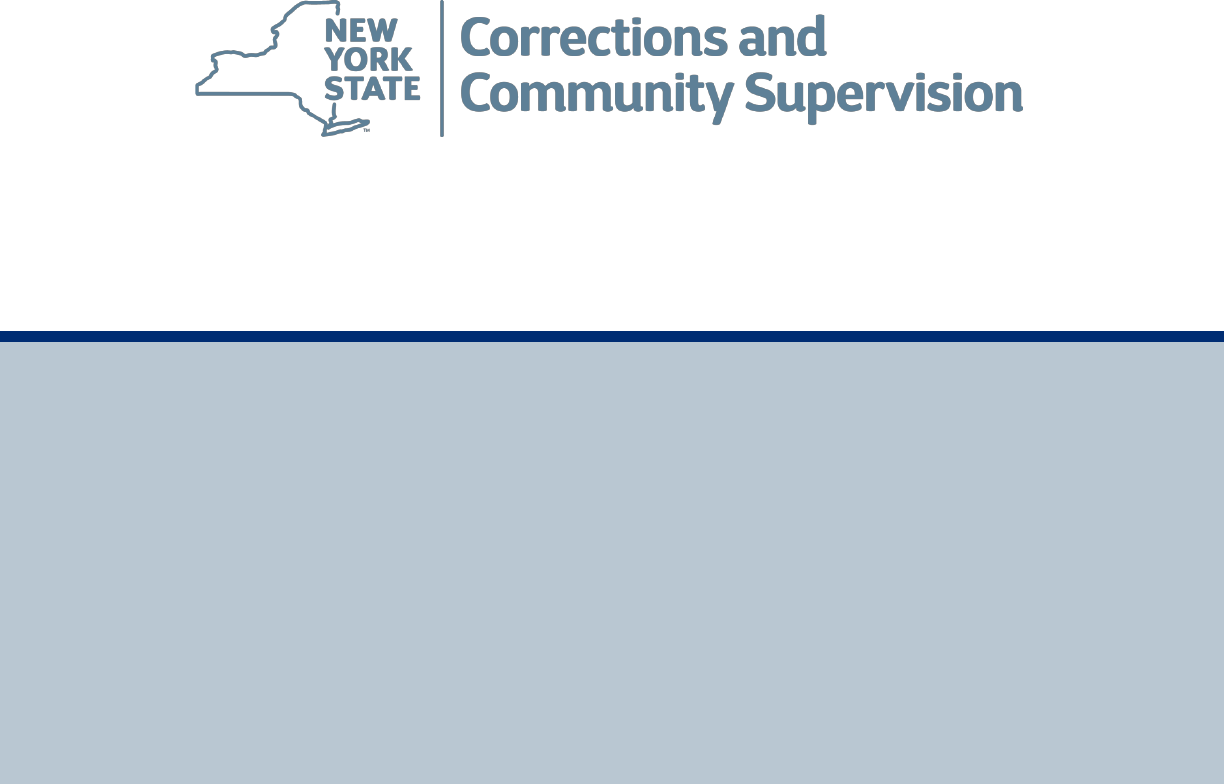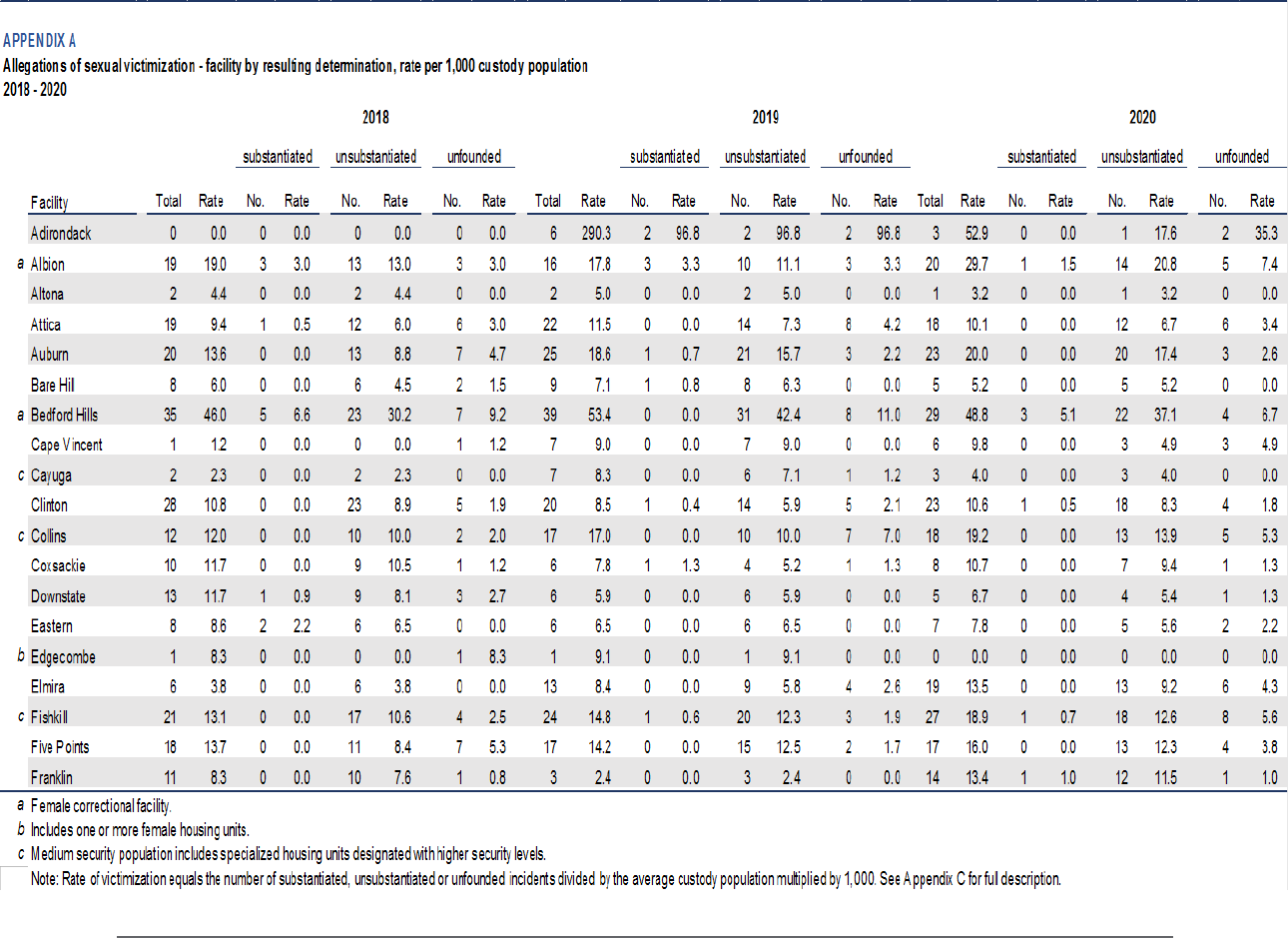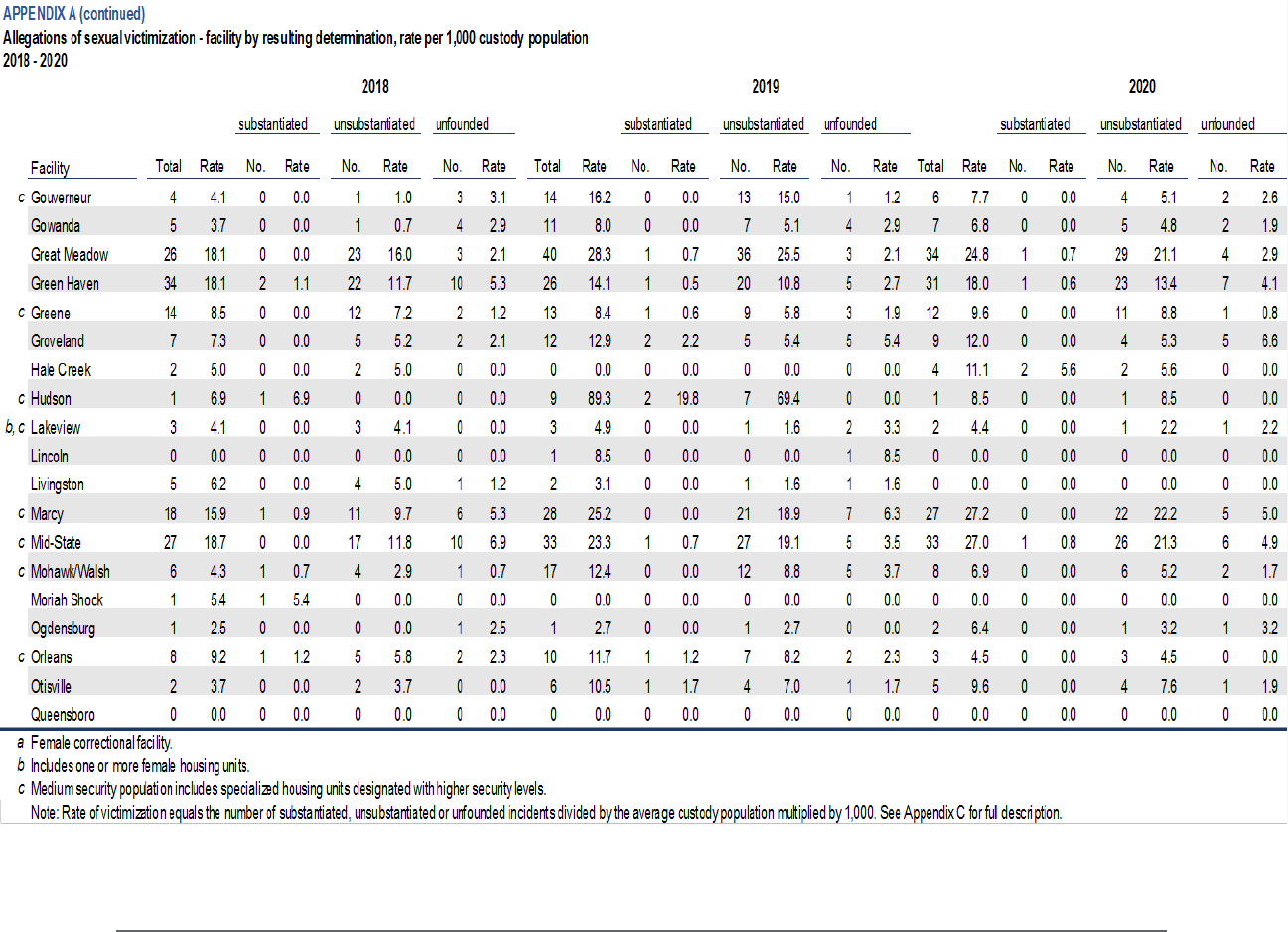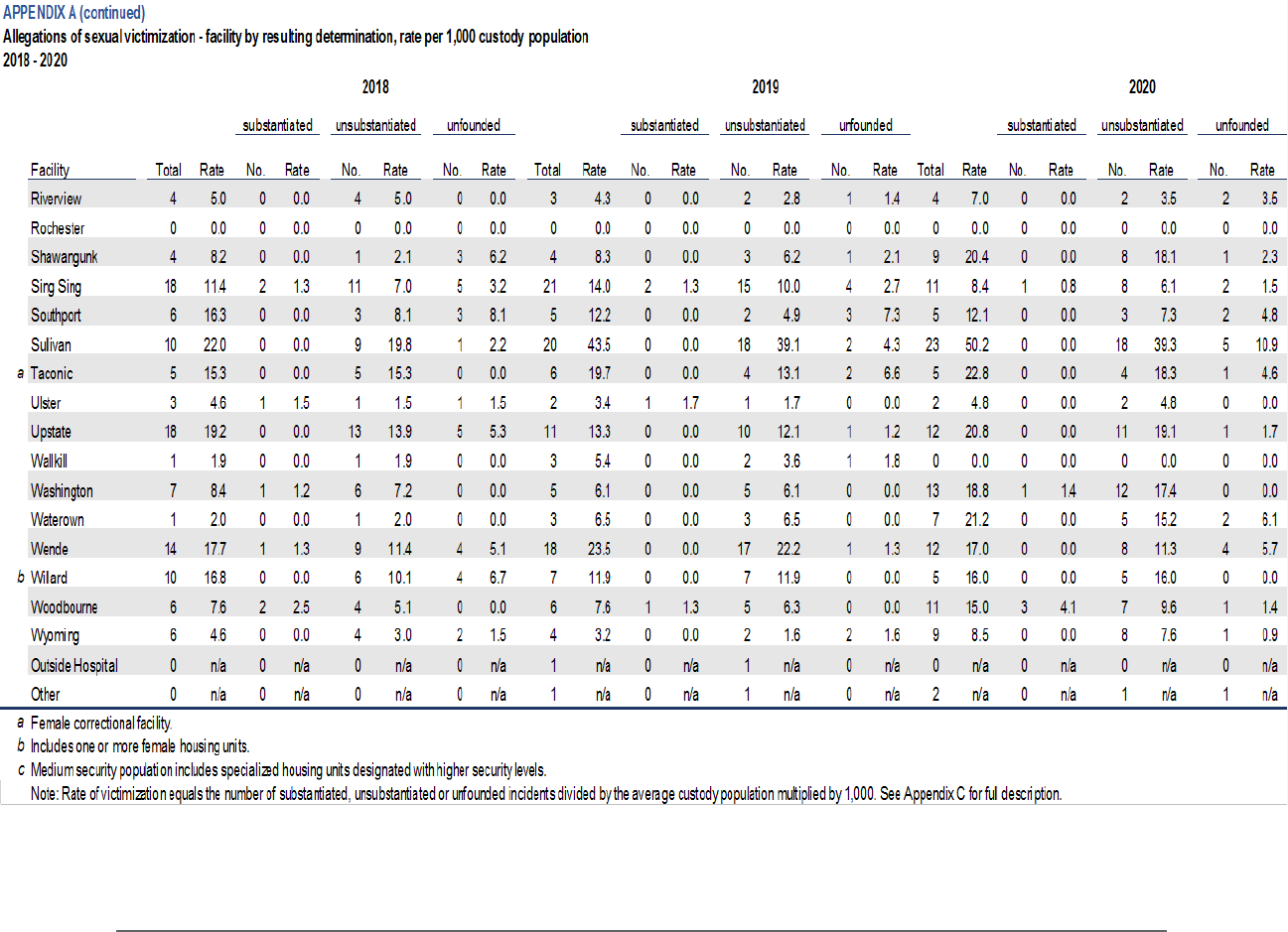
KATHY HOCHUL
Governor
DANIEL F. MARTUSCELLO III
Acting Commissioner
JASON D. EFFMAN
Associate Commissioner
PREA Coordinator
D O C C S V I S I O N A N D M I S S I O N
The New York State Department of Corrections and Community Supervision, guided by
the Departmental Mission, is responsible for the confinement and rehabilitation of approximately
32,000 incarcerated individuals at 44 state facilities, and the supervision of approximately
18,000 releasees, throughout seven regional offices statewide. Our mission is to ensure public
safety by operating safe and secure facilities, preparing individuals for release, and then
supervising them to be successful when they return home from prison.
DOCCS' vision is to enhance public safety by having incarcerated persons return home under
supportive supervision less likely to revert to criminal behavior.
The Harriman State Campus, 1220 Washington Avenue, Albany, NY 12226-2050 I www.doccs.ny.gov
ANNUAL REPORT ON
SEXUAL VICTIMIZATION
AN ANALYSIS OF 2016 – 2020
SEXUAL ABUSE AND SEXUAL HARASSMENT DATA
PUBLISHED JUNE 2023

TABLE OF CONTENTS
Page
Introduction…………………………………………………………………………………......1
Section:
1. Allegations of Sexual Abuse and Sexual Harassment……………….….2
2. Resulting Determinations………………………………………………….….7
3. Substantiated Allegations…………..…………………………………….…..9
4. Review for Corrective Action…………………………...............…….…...10
Conclusion……………………………………………………………………………………...14
Appendix A: Allegations of Sexual Victimization by Facility……………………….....15
Appendix B: Allegations of Sexual Victimization Reported in CY 2021 and 2022…18
Appendix C: Data Collection and Review § 115.87 and § 115.88………………….…..20
Appendix D: Definitions of Sexual Victimization…………………………………….…..21

The Harriman State Campus, 1220 Washington Avenue, Albany, NY 12226-2050 │ (518) 457-8126 │ www.doccs.ny.gov
1
INTRODUCTION
Establishment of the Prison Rape Elimination Act
The Prison Rape Elimination Act of 2003 (PREA Public Law 108-79) established federal
mandates to identify and prevent prison rape in correctional facilities within the jurisdictions of
federal, state, local, and native territories across the United States. Public Law 108-79 was
signed into law on September 4, 2003.
The United States Department of Justice adopted the National Standards to Prevent, Detect,
and Respond to Prison Rape (the PREA Standards) effective August 20, 2012. In addition to
establishing mandatory standards for prevention, detection and response to prison sexual abuse
and sexual harassment, the PREA Standards require all correctional facilities to conduct sexual
abuse incident reviews and collect uniform data using standardized definitions. Agencies must
ensure that data collection includes allegations of sexual abuse and sexual harassment at
facilities under its direct control. This incident-based sexual abuse information must be
aggregated and made readily available to the public at least annually.
The New York State Department of Corrections and Community Supervision (DOCCS)
publishes this report in compliance with PREA Standards §115.87 Data Collection and § 115.88
Data Review for Corrective Action (see Appendix C).
This report provides a comparison of allegations of sexual abuse and sexual harassment as
reported to the Bureau of Justice Statistics (BJS) for calendar years 2016 – 2020, as well as
corrective actions taken at facilities and the agency as a whole. This annual report includes
allegations of sexual abuse of incarcerated individuals within correctional facilities under the
jurisdiction of DOCCS. Allegations of sexual abuse and sexual harassment are preliminary and
subject to change as these cases develop. The allegation categories are not final for cases that
are ongoing or pending resolution. Data used in this report reflects the most current information
available at the time of publication.
In accordance with PREA Standard 115.89 (b), the most recently reported aggregated sexual
abuse data from facilities under DOCCS direct control and private facilities with which DOCCS
contracts, is attached to this report as Appendix B.
Categorizations of allegations of sexual abuse and sexual harassment are based on the most
recent definitions provided by BJS and reporting requirements as specified in the National
Standards to Prevent, Detect, and Respond to Prison Rape, under 28 CFR part 115 (see
Appendix D). Reports include comparisons of previous years’ data where appropriate.

The Harriman State Campus, 1220 Washington Avenue, Albany, NY 12226-2050 │ (518) 457-8126 │ www.doccs.ny.gov
2
Section One
ALLEGATIONS OF SEXUAL ABUSE AND SEXUAL HARASSMENT
The following section contains data on sexual abuse and sexual harassment allegations reported
over a five-year period. These allegations represent complaints, which became investigative
cases from January 2016 through December 2020. This section is intended to provide an
informed overview of these allegations statewide. In accordance with the National PREA
Standards, DOCCS reviews the data collected and aggregated pursuant to §115.87, in order to
assess and improve the effectiveness of its sexual abuse prevention, detection, response
policies, practices, and training, in an effort to understand and eliminate sexual abuse and sexual
harassment within New York State correctional facilities.
Type of Allegation
Uniform definitions provided by the Bureau of Justice Statistics (BJS) and the Prison Rape
Elimination Act of 2003 are used in order to categorize allegations of sexual abuse and sexual
harassment within DOCCS correctional facilities. These categories separate allegations by
perpetrator type (staff or incarcerated population) as shown in Table 1.
Category type by year
2016 - 2020
Category Type 2016 2017 2018 2019 2020
Total Allegations 450 383 511 592 631
Staff
Staff sexual misconduct 236 225 295 329 318
Staff sexual harassment 95 71 105 153 164
Sub-Total 331 296 400 482 482
Incarcerated Population
Non-Consensual Sexual Acts 71 58 73 64 84
Abusive Sexual Contacts 24 18 17 7 20
Sexual Harassment 24 11 21 39 45
Sub-Total 119 87 111 110 149
Data accurate as of file date 12/30/2022.
Table 1
Allegations of Sexual Victimization, 2016 - 2020

The Harriman State Campus, 1220 Washington Avenue, Albany, NY 12226-2050 │ (518) 457-8126 │ www.doccs.ny.gov
3
Overview
The New York State Department of Corrections and Community Supervision (DOCCS) utilizes
uniform definitions as described in this section, pursuant to 28 C.F.R §115.6 in the National
Standards to prevent, Detect, and Respond to prison Rape (under the Prison Rape Elimination
Act of 2003). These titled definitions are used to categorize allegations of sexual abuse and
sexual harassment within New York State correctional facilities and to separate allegations by
perpetrator type (staff or incarcerated individual) and type of abuse (see Appendix D for complete
definitions).
The number of reported allegations includes attempted as well as completed allegations of
sexual abuse and sexual harassment. The total number of sexual abuse and sexual harassment
allegations increased by 7% from 2019 to 2020 (592 and 631, respectively). Increased reporting
was expected, in light of the implementation of a number of new PREA-based initiatives in recent
years, including the Statewide Rape Crisis Hotline (see previous Annual Report
1
) and the impact
of implementation efforts. Starting in April 2020, incarcerated individuals in disciplinary
confinement settings were provided with access to telephone-enabled tablets. This provided
direct access to both the 444 OSI reporting line and the 777 rape crisis hotline. This direct
telephone access drove an increase in reporting, including bad faith reports.
It is also noted that 2020 saw a number of PREA-related allegations that were substantiated for
non-PREA categorized related forms of misconduct. The number of substantiated allegations of
misconduct during the height of the pandemic is consistent with increased reporting. It also
appears that a number of factors directly attributed to the pandemic response influenced
reporting. This included the pause in programs, increased feelings of isolation, and general
stress related to COVID-19.
Staff Sexual Misconduct
Staff Sexual Misconduct includes a wide range of behaviors such as attempted or requested
sexual acts, indecent exposure, invasion of privacy and staff voyeurism, as well as completed
sexual acts and unwanted touching for sexual gratification. Under New York State Penal Law §
130.05 (3)(e), incarcerated individuals are unable to consent to sexual acts with Department
employees. In 2020, this category represented 50% of all allegations. There were 318 staff
sexual misconduct allegations reported in 2020, down 11 (3%) from 329 in 2019 (see Table 1).
1
New York State Department of Corrections and Community Supervision. (2022, April). Annual Report on Sexual Victimization: An Analysis of 2015 – 2019
Data. Author. https://doccs.ny.gov/system/files/documents/2022/04/annual-report-on-sexual-victimization-2015-2019-with-2020-aggregated-data-
final.pdf.

The Harriman State Campus, 1220 Washington Avenue, Albany, NY 12226-2050 │ (518) 457-8126 │ www.doccs.ny.gov
4
Staff Sexual Harassment
Staff sexual harassment includes repeated verbal statements, and comments or gestures of a
sexual nature, to an incarcerated individual or incarcerated releasee by a staff member. Staff
sexual harassment allegations represented 26% of all allegations in 2020. Staff sexual
harassment allegations increased by 7% between 2019 and 2020 (153 and 164, respectively).
Incarcerated Individual Nonconsensual Act
Nonconsensual acts are defined as sexual contact or penetration of any person without their
consent, or of a person who is unable to consent or refuse. The number of cases in this category
increased by 31% from 2019 to 2020 (64 and 84, respectively) and represented 13% of all
allegations reported in 2020.
Incarcerated Individual Abusive Act
Incarcerated individual abusive acts are defined as unwanted intentional touching of an
incarcerated individual without his or her consent, or of an incarcerated individual who is unable
to consent or refuse, by another incarcerated individual. Incarcerated individual abusive acts
represented 3% of total allegations reported to DOCCS in 2020. The number of allegations of
incarcerated individual abusive acts increased by 13 from 2019 to 2020 (7 and 20, respectively).
Incarcerated Individual Sexual Harassment
In 2013, the Bureau of Justice Statistics added Incarcerated individual Sexual Harassment to
the definitions of sexual victimization. Incarcerated individual Sexual Harassment is defined as
repeated and unwanted sexual advances, requests for sexual favors, or verbal comments,
gestures, or actions of a derogatory or offensive sexual nature by one incarcerated individual or
incarcerated releasee directed toward another. There were 45 incarcerated individual sexual
harassment allegations reported in 2020 compared to 39 in 2019, an increase of 15%.

The Harriman State Campus, 1220 Washington Avenue, Albany, NY 12226-2050 │ (518) 457-8126 │ www.doccs.ny.gov
5
Rate of Reported Allegations
The rate of reported allegations of sexual victimization increased from 12.8 per 1,000 individuals
under custody in 2019 to 16.1 per 1,000 individuals under custody in 2020. The rate of
allegations concerning staff increased from 10.5 per 1,000 individuals in 2019 to 12.3 per 1,000
individuals in 2020. The rates of allegations among the incarcerated population increased from
2.4 per 1,000 individuals in 2019 to 3.8 per 1,000 individuals in 2020.
It is generally expected that victimization among incarcerated individuals has been historically
under-reported. As a result, strategic measures have been implemented to promote their
willingness to report.
Ongoing implementation efforts have also increased familiarity with sexual victimization
prevention and response procedures. Further, overall compliance efforts, together with
increasingly focused investigative responses, have increased confidence in the system to
address complaints appropriately. Conversely, the agency continues to experience significant
numbers of unfounded and bad faith reports (see Section 2). While DOCCS cannot fully explain
the driving forces behind the knowing bad faith reports, many may relate to efforts to avoid
responsibility for other behavior or are part of a misguided effort to expedite an investigative
response for an incident that may have occurred but did not involve any form of sexual
victimization.
The issue of bad faith reporting has become a national concern. Over the past year, partners of
the U.S. Department of Justice PREA Management Office have begun discussing the issue in
workshops at American Correctional Association conferences, and it has also been a topic of
discussion at national PREA Coordinator conferences. In March 2023, the PREA Resource
Center has engaged a partner through their cooperative agreement to develop resources to
better understand the problem and to explore how to mitigate and address such issues. DOCCS
has been invited to be a part of the advisory workgroup supporting these efforts.

The Harriman State Campus, 1220 Washington Avenue, Albany, NY 12226-2050 │ (518) 457-8126 │ www.doccs.ny.gov
6
Category type by year
2016 - 2020
Category Type
2016 2017 2018 2019 2020
Annual Rate 8.7 7.5 10.4 12.8 16.1
Staff Type
Staff sexual misconduct 4.5 4.4 6.0 7.1 8.1
Staff sexual harassment 1.8 1.4 2.1 3.3 4.2
Staff Rate 6.4 5.8 8.1 10.5 12.3
Incarcerated Population
Non-Consensual Sexual Acts 1.4 1.1 1.5 1.4 2.1
Abusive Sexual Contacts 0.5 0.4 0.3 0.2 0.5
Sexual Harassment 0.5 0.2 0.4 0.8 1.1
Incarcerated Rate 2.3 1.7 2.3 2.4 3.8
Rate per 1,000 custody population
Table 2
Rate of allegations of sexual victimization, 2016 - 2020

The Harriman State Campus, 1220 Washington Avenue, Albany, NY 12226-2050 │ (518) 457-8126 │ www.doccs.ny.gov
7
Section Two
RESULTING DETERMINATIONS
Resulting determinations from completed investigations are classified as Substantiated,
Unsubstantiated, or Unfounded as defined by the PREA Standards (28 C.F.R. § 115). Resulting
determinations are fully defined in Appendix D (p. 18).
Among completed investigations between 2016 and 2020, a number of resulting determinations
concluded that there was sufficient evidence to confirm a report of sexual abuse or sexual
harassment. These cases are referred to as substantiated. The number of substantiated cases
ranged from a low of 13 in 2016 (2.9% of reported incidents) to 26 in 2018 (5.1% of reported
incidents). In 2020, 2.7% of allegations (17 cases) were substantiated. It is also noted that cases
with multiple types of allegations that are substantiated for non-PREA defined forms of
misconduct are reflected as unsubstantiated.
When a report is substantiated for sexual abuse, sexual harassment or another form of
misconduct, criminal prosecution and disciplinary action will be pursued commensurate with the
nature and circumstances of the acts committed.
Among completed investigations between 2016 and 2020, most resulting determinations
concluded that evidence was insufficient to determine whether the event occurred. These cases
are referred to as unsubstantiated. In 2020, 67.8% of allegations were determined to be
unsubstantiated.
Unfounded determinations are reports submitted that are proved to be false. All allegations of
sexual abuse and sexual harassment are taken seriously and investigated thoroughly. Between
2016 and 2020, the rate of false reports ranged from 18.2% of reported incidents in 2020 to
28.7% of reported incidents in 2017.
Of the sexual abuse and sexual harassment allegations reported in 2020, 115 were determined
to be unfounded (18.2% of reported incidents). In these cases, the Office of Special
Investigations determined that the event did not occur by, for example, the presence of evidence
contradictory to the allegation or an incarcerated individual’s self-admission to falsifying the
allegation. Some of these cases resulted in a determination that the complaint was made in bad
faith, that is, that it was a knowingly false complaint made with malice. In others, incarcerated
individuals, who have reported experiencing physical violence, have admitted making a false
sexual violence claim believing that doing so would expedite the investigative process.

The Harriman State Campus, 1220 Washington Avenue, Albany, NY 12226-2050 │ (518) 457-8126 │ www.doccs.ny.gov
8
The number of open cases (classified as “Ongoing”) represent more recent allegations which
were still ongoing at the time of data collection. In 2020, 11.3% percent (71 of 631) of the sexual
victimization investigations were ongoing at the time of data collection.
Table 3
Distribution of determinations of sexual victimization, 2016 - 2020
Resulting determination by year
Completed 450 100.0% 383 100.0% 511 100.0% 592 100.0% 560 88.7%
Substantiated 13 2.9% 20 5.2% 26 5.1% 24 4.1% 17 2.7%
Unsubstantiated 329 73.1% 252 65.8% 362 70.8% 455 76.9% 428 67.8%
Unfounded 108 24.0% 110 28.7% 123 24.1% 110 18.6% 115 18.2%
Other 0 0.0% 1 0.3% 0 0.0% 3 0.5% 0 0.0%
Ongoing 0 0.0% 0 0.0% 0 0.0% 0 0.0% 71 11.3%
Total allegations 450 100.0% 383 100.0% 511 100.0% 592 100.0% 631 100.0%
2020
2019
Resulting determinations classified as "Other" represent cases which may have been administratively closed, or may
have resulted in multiple determinations.
2017
2018
2016
Cases with multiple types of allegations that are substantiated for non-PREA defined forms of misconduct are
reflected as unsubstantiated.

The Harriman State Campus, 1220 Washington Avenue, Albany, NY 12226-2050 │ (518) 457-8126 │ www.doccs.ny.gov
9
Section Three
SUBSTANTIATED ALLEGATIONS
Allegations of sexual abuse or sexual harassment are substantiated after an event is
investigated and determined to have occurred based on a preponderance of evidence.
The percentage of substantiated cases decreased from 5.2% in 2017 to 2.7% in 2020. In most
years, the majority of these allegations were staff related, as shown in Table 4. In 2020, 82% of
the substantiated cases involved staff.
Category type by year
2016 - 2020
Category Type 2016 2017 2018 2019 2020
Total Substantiated 13 20 26 24 17
Percent of total allegations 2.9% 5.2% 5.1% 4.1% 2.7%
Staff Type
Staff sexual misconduct 7 15 17 9 9
Staff sexual harassment 0 2 2 2 5
Sub-Total 7 17 19 11 14
Percent of total staff allegations 2.1% 5.7% 4.8% 2.3% 2.9%
Incarcerated Individuals
Non-Consensual Sexual Acts 2 1 4 1 0
Abusive Sexual Contacts 3 2 2 2 1
Sexual Harassment 1 0 1 10 2
Sub-Total 6 3 7 13 3
Percent of total incarcerated individual allegations 5.0% 3.4% 6.3% 11.9% 2.0%
Table 4
Substantiated Allegations of Sexual Victimization 2016 - 2020

The Harriman State Campus, 1220 Washington Avenue, Albany, NY 12226-2050 │ (518) 457-8126 │ www.doccs.ny.gov
10
Section Four
REVIEW FOR CORRECTIVE ACTION
Pursuant to PREA Standard § 115.88, DOCCS continues to assess and improve the
effectiveness of its sexual abuse prevention, detection, and response policies, practices, and
training. This includes (1) identifying problem areas; (2) taking corrective action on an ongoing
basis; and (3) preparation of this annual report.
To this end, this report includes a comparison of the current year’s data and corrective actions
with those from prior years and provides an assessment of the agency’s progress in addressing
sexual abuse. As previously referenced in this report, strategic measures have been
implemented to promote an incarcerated individual or incarcerated releasee’s willingness to
report. DOCCS Office of Special Investigations (OSI) expanded access to the “444” reporting
line in October 2019. This telephone reporting line is available to all incarcerated individuals and
incarcerated releasees during regular business hours.
Expanding on the existing partnership established with the New York State Coalition Against
Sexual Assault (NYSCASA), DOCCS has entered into a partnership with the New York State
Office of Victim Services and the Office for the Prevention of Domestic Violence. The Enhanced
Victim Services program now provides hotline and victim advocacy services at facilities
statewide.
In 2019, DOCCS leveraged funding from a 2017 PREA Reallocation of Byrne-JAG funding to
provide a total of fifty (50) Office of Special Investigations (OSI), Sex Crimes Division (SCD)
investigative staff, Assistant Deputy Superintendent PREA Compliance Managers and Central
Office staff with Forensic Experiential Trauma Interview (FETI) training. “Certified FETI” is a
science and practice-based interviewing methodology informed by the latest research on the
neurobiology of trauma and memory. It is a “participant-centered” methodology that allows the
interviewer to help the participant (a victim, witness, or other involved person) remember as
many details as they are able about a potentially traumatic event in a sensitive, non-
confrontational manner.
By adopting cutting edge investigative techniques into the work of the OSI SCD, DOCCS expects
to continue improving on the quality of its investigations and the reliability of investigative
determinations. Ensuring appropriate disciplinary action or criminal prosecution of abusers is
key to protecting all incarcerated individuals and incarcerated releasees from sexual
victimization.

The Harriman State Campus, 1220 Washington Avenue, Albany, NY 12226-2050 │ (518) 457-8126 │ www.doccs.ny.gov
11
DOCCS implemented a pair of trainings in the 1st quarter of 2020 which included “Ensuring
Professional Interactions with LGBTIQ+ People” and an updated version of the biennial PREA
Refresher Training. DOCCS completed work with outside partners on a grant project to develop
a new staff refresher training for calendar year 2022. This training relied on data from 2019-
2020, staff focus groups, and incarcerated individual focus groups as its foundation. The training,
“Preventing Sexual Misconduct and Saving Careers,” uses a new bystander intervention
approach and is intended to 1) empower staff to intervene when they observe coworkers
displaying poor professional boundaries; 2) encourage reporting of signs of boundary violations,
even if the staff person does not observe signs of sexual misconduct; and 3) improve overall
awareness with messaging that is intended to resonate with the target audience.
In recent years, DOCCS has been aggressively increasing the use of video surveillance within
the Department’s Correctional Facilities. This includes the implementation of fixed video
surveillance systems in a growing number of facilities, as well as the use of body-worn cameras
to monitor operations in nine facilities.
DOCCS used a multidisciplinary team to examine where cameras would be placed within
facilities on future projects and included an eye toward the prevention and detection of sexual
victimization. A number of multimillion-dollar camera projects are in various stages across the
system.
DOCCS is continuing to supplement its use of data to inform policy decisions by collecting
information from impacted individuals to improve policy and practice. This includes structured
interviews of former employees facing conviction for crimes related to sexual victimization in
prison, interviewing recently released individuals, and having formal and informal conversations
with current staff and incarcerated individuals. The information is being compiled for use by
various working groups to inform a number of initiatives that address training and policy
improvements.
A number of new proactive measures have been adopted and others are being pursued.
Investigators make unannounced inspections at correctional facilities, which include searches
of employees and their workspaces where evidence of misconduct may be uncovered. DOCCS
Office of Special Investigations (OSI) is collaborating with the Law Enforcement Psychological
Services (LEPS), which is a national psychological screening firm, to potentially develop a sexual
abuser psychological profile to improve the psychological exams for correction officer
candidates. Further, in 2022, OSI added a new analysis unit, which will provide case support to
OSI’s increasingly complex investigations, including analysis of information to identify evidence
that could then be used for disciplinary proceedings and criminal prosecutions.

The Harriman State Campus, 1220 Washington Avenue, Albany, NY 12226-2050 │ (518) 457-8126 │ www.doccs.ny.gov
12
Recognizing that successful implementation of sexual victimization prevention policies requires
the support of prosecuting authorities, DOCCS has increased its outreach and education efforts
towards those who ultimately decide what cases will be pursued. It is important that prosecutors
are informed about the PREA Standards and the Department’s implementation efforts.
Supervisors from OSI SCD will often meet with representatives of a District Attorney to present
cases for prosecution, and to emphasize the importance of pursuing cases not only for the
individual victim, but to advance public integrity and safety. Where appropriate, OSI also works
with other prosecuting authorities, including the Office of the New York Attorney General and the
U.S. Attorneys’ Offices within New York.
Facility-specific corrective actions taken are reflected in Table 5 (p. 13).

The Harriman State Campus, 1220 Washington Avenue, Albany, NY 12226-2050 │ (518) 457-8126 │ www.doccs.ny.gov
13
Ensured OMH referrals are timely; completed re-training.
Identified locations for cameras upon system upgrade.
Reinforced need for prompt medical assessment per policy.
Laundry folding tables/chairs removed from laundry rooms and placed in view of camera.
Noted organized system for camera reviews conducted by ET.
Reinforced need for increased supervisory rounds.
Identified need for camera facing the draft holding cell.
Coordinated response training for WC.
Notified WC to complete checklist; reiterated need for an updated risk assessment after every allegation of abuse.
AUBURN
Installed camera system.
Addition of a vision panel for the storage closet in the mess hall kitchen.
Identified locations for cameras upon system upgrade.
Added vision panels to all solid doors, as appropriate.
Requested addition of cameras in stairwells.
Implemented procedures for early retrieval of medical/mental health records to facilitate review.
Reinforced with pertinent staff the requirement to notifiy OSI in a timely manner.
Reinforced training on investigations for Security Supervisors, particularly as it pertains to submitting OMH
Referrals.
Encouraged communication between Security Supervisors and Watch Commanders as it pertains to the use of
body worn cameras on trips.
Reinforced with staff the proper completion of the Watch Commander Checklist.
Implemented steps to improve communication with OSI.
Reinforced procedures to preserve video relative to reports.
Conducted security supervisor training regarding notification procedures and documentation.
Training conducted with medical regarding assessments and proper documentation.
EASTERN
Requested expansion of CCTV system.
DSH conducted training with medical staff to review HSPM 1.60.
Medical Dept continues to review/discuss staff boundaries/familiarization.
Security assessment done regarding protocols/procedure for area. Reviewed findings at Security Supervisors
meeting.
Collect records required to complete an Incident Review within 30 days following an allegation.
Implemented tracking system to ensure all incarcerated individuals receive PREA Risk screening, receive
orientations materials and watch the PREA education video.
Memo to draft officers to issue pamphlets in primary language and to document such.
Reminded supervisors that pat frisk memos need to include whether or not body worn camera was in use.
Reminder provided to appropriate staff to ensure video footage is preserved, when available.
MARCY
Retraining for security and medical staff; docuented via memo.
MID-STATE
Staff training and supervision of employees.
SHAWANGUNK
Requested expansion of CCTV system facility wide.
SULLIVAN
Requested Body Worn Camera system and facility wide CCTV. Body worn camera pilot system initiated.
Reviewed FOM 602 PREA Risk Screening with Guidance Staff
Review HSPM1.60 with Medical to ensure proper documentation is received.
Collect records required to complete an Incident Review within 30 days following an allegation.
Continued efforts to improve timely communication to the facility when allegations are reported to offices outside
the facility.
Identified failure to properly complete Watch Commander’s Sexual Abuse Response Sheet; addressed with staff.
OMH referral not completed in timely manner. Addressed with staff.
WOODBOURNE
Issued memorandum to staff about misgendering.
WENDE
Table 5
Facility Specific Corrective Actions Taken for Calendar Year 2021
ALBION
BEDFORD HILLS
COLLINS
CLINTON
ATTICA
UPSTATE
WASHINGTON
ELMIRA
GREAT MEADOW
GREENE

The Harriman State Campus, 1220 Washington Avenue, Albany, NY 12226-2050 │ (518) 457-8126 │ www.doccs.ny.gov
14
CONCLUSION
A comparison of data from 2016 to 2020 shows an increase in reports of sexual abuse and
sexual harassment beginning in 2018. DOCCS is working to develop new strategies to address
all forms of sexual victimization within the agency’s facilities, with a focus on staff sexual
misconduct and reinforcing professional boundaries. DOCCS ensures that multi-disciplinary
teams participate in national conferences with an eye toward identifying promising practices for
potential implementation and collaborating with others, to develop new strategies to address
sexual victimization.
The Department is continuing its current efforts to educate staff and all those under custody, to
conduct thorough and reliable investigations into reports of sexual victimization, and to pursue
prosecution and discipline commensurate with the nature and circumstances of the misconduct.
These efforts include specialized trainings for persons in key roles including Assistant Deputy
Superintendent PREA Compliance Managers, PREA Point Persons, Medical Staff and Office of
Special Investigations (OSI) Sex Crimes Investigators. e Department will also continue on the
path of expanding the use of technology to dissuade and detect misconduct, including the
installation of fixed video surveillance systems at a number of facilities, and increasing the use
of body-worn cameras in growing numbers of facilities.
Such efforts have shifted the culture of the Department and continue to reinforce the message
that the Department of Corrections and Community Supervision has zero tolerance for sexual
abuse and sexual harassment.

The Harriman State Campus, 1220 Washington Avenue, Albany, NY 12226-2050 │ (518) 457-8126 │ www.doccs.ny.gov
15

The Harriman State Campus, 1220 Washington Avenue, Albany, NY 12226-2050 │ (518) 457-8126 │ www.doccs.ny.gov
16

The Harriman State Campus, 1220 Washington Avenue, Albany, NY 12226-2050 │ (518) 457-8126 │ www.doccs.ny.gov
17

The Harriman State Campus, 1220 Washington Avenue, Albany, NY 12226-2050 │ (518) 457-8126 │ www.doccs.ny.gov
18
APPENDIX B
State-operated confinement facilities
Incarcerated Population
Nonconsensual
Acts
Abusive Sexual
Contact
Sexual
Harassment
Total
Substantiated 0 2 1 3
Unsubstantiated 50 6 18 74
Unfounded 12 3 2 17
Ongoing 25 3 5 33
Total allegations reported 87 14 26 127
Staff
Sexual
Harassment
Total
Substantiated 3 6
Unsubstantiated 56 243
Unfounded 17 59
Ongoing 23 133
Total allegations reported 99 441
State Operated confinement facilities excludes outside hospital allegations and other non-facility locations.
Community-based residential program sites
Releasees
Nonconsensual
Acts
Abusive Sexual
Contact
Sexual
Harassment
Total
Substantiated 0 0 0 0
Unsubstantiated 1 0 1 2
Unfounded 0 0 0 0
Ongoing 0 0 0 0
Total allegations reported 1 0 1 2
Staff
Sexual
Harassment
Total
Substantiated 0 0
Unsubstantiated 0 1
Unfounded 0 0
Ongoing 0 0
Total allegations reported 0 1
Data accurate as of file date 12/30/2022.
Excludes cases closed out to another case# where an investigation already exists for an associated complaint.
Incident frequency by category type: Calendar year 2021
3
Reported Allegations of Sexual Abuse and Sexual Harassment
Created in compliance with PREA Standard 115.89 (b)
Sexual Misconduct
Uniform definitions provided by the Bureau of Justice Statistics (BJS) and the Prison Rape Elimination Act of 2003 are used
in order to categorize allegations of sexual abuse and sexual harassment within DOCCS correctional facilities. These
categories separate allegations by perpetrator type (staff type, incarcerated individual or releasee).
187
42
110
342
Sexual Misconduct
0
1
0
0
1

The Harriman State Campus, 1220 Washington Avenue, Albany, NY 12226-2050 │ (518) 457-8126 │ www.doccs.ny.gov
19
APPENDIX B
State-operated confinement facilities
Incarcerated Population
Nonconsensual
Acts
Abusive Sexual
Contact
Sexual
Harassment
Total
Substantiated 0 0 1 1
Unsubstantiated 16 2 5 23
Unfounded 5 1 0 6
Ongoing 69 5 16 90
Total allegations reported 90 8 22 120
Staff
Sexual
Harassment
Total
Substantiated 4 7
Unsubstantiated 14 70
Unfounded 1 15
Ongoing 88 402
Total allegations reported 107 494
State Operated confinement facilities excludes outside hospital allegations and other non-facility locations.
Community-based residential program sites
Releasees
Nonconsensual
Acts
Abusive Sexual
Contact
Sexual
Harassment
Total
Substantiated 0 0 0 0
Unsubstantiated 0 0 0 0
Unfounded 0 0 0 0
Ongoing 0 0 0 0
Total allegations reported 0 0 0 0
Staff
Sexual
Harassment
Total
Substantiated 0 0
Unsubstantiated 0 0
Unfounded 0 0
Ongoing 0 0
Total allegations reported 0 0
Data accurate as of file date 12/30/2022.
Excludes cases closed out to another case# where an investigation already exists for an associated complaint.
3
Incident frequency by category type: Calendar year 2022
Reported Allegations of Sexual Abuse and Sexual Harassment
Created in compliance with PREA Standard 115.89 (b)
Sexual Misconduct
Uniform definitions provided by the Bureau of Justice Statistics (BJS) and the Prison Rape Elimination Act of 2003 are used
in order to categorize allegations of sexual abuse and sexual harassment within DOCCS correctional facilities. These
categories separate allegations by perpetrator type (staff type, incarcerated individual or releasee).
56
14
314
387
Sexual Misconduct
0
0
0
0
0

The Harriman State Campus, 1220 Washington Avenue, Albany, NY 12226-2050 │ (518) 457-8126 │ www.doccs.ny.gov
20
APPENDIX C
Title 28 - Judicial Administration
Volume: 2
Date: 2012-07-01
Original Date: 2012-07-01
Title: Subpart A - Standards for Adult Prisons and Jails
Context: Title 28 - Judicial Administration.
CHAPTER I - DEPARTMENT OF JUSTICE (CONTINUED).
PART 115 - PRISON RAPE ELIMINATION ACT NATIONAL STANDARDS.
Subpart A—Standards for Adult Prisons and Jails
§ 115.87 Data collection.
(a) The agency shall collect accurate, uniform data for every allegation of sexual abuse at facilities under its
direct control using a standardized instrument and set of definitions.
(b) The agency shall aggregate the incident-based sexual abuse data at least annually.
(c) The incident-based data collected shall include, at a minimum, the data necessary to answer all questions
from the most recent version of the Survey of Sexual Violence conducted by the Department of Justice.
(d) The agency shall maintain, review, and collect data as needed from all available incident-based documents,
including reports, investigation files, and sexual abuse incident reviews.
(e) The agency also shall obtain incident-based and aggregated data from every private facility with which it
contracts for the confinement of its inmates.
(f) Upon request, the agency shall provide all such data from the previous calendar year to the Department of
Justice no later than June 30.
§ 115.88 Data review for corrective action.
(a) The agency shall review data collected and aggregated pursuant to § 115.87 in order to assess and
improve the effectiveness of its sexual abuse prevention, detection, and response policies, practices, and
training, including by:
(1) Identifying problem areas;
(2) Taking corrective action on an ongoing basis; and
(3) Preparing an annual report of its findings and corrective actions for each facility, as well as the agency
as a whole.
(b) Such report shall include a comparison of the current year’s data and corrective actions with those from
prior years and shall provide an assessment of the agency’s progress in addressing sexual abuse.
(c) The agency’s report shall be approved by the agency head and made readily available to the public through
its website or, if it does not have one, through other means.
(d) The agency may redact specific material from the reports when publication would present a clear and
specific threat to the safety and security of a facility but must indicate the nature of the material redacted.

The Harriman State Campus, 1220 Washington Avenue, Albany, NY 12226-2050 │ (518) 457-8126 │ www.doccs.ny.gov
21
APPENDIX D
DEFINITIONS OF SEXUAL VICTIMIZATION
The New York State Department of Corrections and Community Supervision (DOCCS) utilizes uniform
definitions as provided by 28 C.F.R. §115.6 in the National Standards to Prevent, Detect, and Respond
to Prison Rape (under the Prison Rape Elimination Act of 2003).
These definitions are used to categorize allegations of sexual abuse within New York State correctional
facilities and to separate allegations by perpetrator type (staff or incarcerated individual) and type of
abuse.
Similar to the Survey on Sexual Victimization (SSV), the following categories of sexual abuse have
been disaggregated into five categories as indicated below.
Incarcerated Individual Nonconsensual Act (I
1
) - sexual contact of any person without his or her
consent, or of a person who is unable to consent or refuse; and
• Contact between the penis and the vulva or the penis and the anus including penetration,
however slight; or
• Contact between the mouth and the penis, vulva, or anus; or
• Penetration of the anal or genital opening of another person, however slight by a hand, finger,
object, or other instrument.
Incarcerated Individual Abusive Act (I
2
) - sexual contact with any person without his or her consent,
or of a person who is unable to consent or refuse; and
• Intentional touching either directly or through the clothing, of the genitalia, anus, groin, breast,
inner thigh, or buttocks of any person.
Incarcerated Individual Sexual Harassment (I
3
) – Repeated and unwanted sexual advances,
requests for sexual favors, or verbal comments, gestures, or actions of a derogatory or offensive sexual
nature by one inmate directed toward another.

The Harriman State Campus, 1220 Washington Avenue, Albany, NY 12226-2050 │ (518) 457-8126 │ www.doccs.ny.gov
22
Staff Sexual Misconduct (S
1
) – any act or behavior of a sexual nature directed toward an inmate by
an employee, volunteer, contractor or official visitor or other agency representative. Sexual
relationships of a romantic nature between staff and inmates are included in this definition. Consensual
and nonconsensual acts include:
• Intentional touching, either directly or through the clothing, of the genitalia, anus, groin, breast,
inner thigh, or buttocks that is unrelated to official duties or with the intent to abuse, arouse or
gratify sexual desire; or
• Completed, attempted, threatened, or requested sexual acts; or
• Occurrences of indecent exposure, invasion of privacy, or staff voyeurism for reasons unrelated
to official duties or for sexual gratification.
Staff Sexual Harassment (S
2
) – Repeated verbal statements, comments, or gestures of a sexual
nature to an inmate by an employee, volunteer, contractor, official visitor, or other agency
representative, including:
• Demeaning references to gender; or sexually suggestive or derogatory comments about body
or clothing.
Repeated profane or obscene language or gestures. FEDERAL CODE OF REGULATIONS
Resulting determinations from completed investigations are classified as outlined verbatim in the Code
of Federal Regulations Title 28, Chapter 1, subpart A, section 115.5, General Definitions (28 C.F.R. §
115.5) as Substantiated, Unsubstantiated, or Unfounded. This standard states that agencies shall
impose no standard higher than a preponderance of the evidence in determining whether allegations
of sexual abuse or sexual harassment are substantiated.
Substantiated – An allegation was investigated and determined to have occurred based on a
preponderance of the evidence.
Unsubstantiated – An allegation was investigated, and the investigation produced insufficient
evidence to make a final determination as to whether or not the event occurred.
Unfounded – An allegation was investigated and determined not to have occurred.
DOCCS also recognizes that at the time of reporting, a final resolution may not yet have been
determined. Under these circumstances, the matter will be identified as “Investigation Ongoing”
indicating that evidence is still being gathered, processed, or evaluated, and a final determination has
not yet been made.
